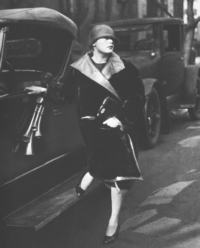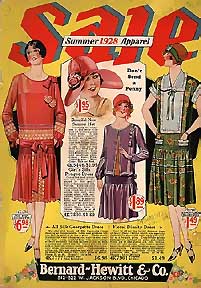|
|
In an article published in the New York Times on March 21,1926,
one man stated that "The mannish look that women strive for today is
ridiculous!" (New York Times, March 21, 1926). This was not quite correct.
By "mannish" the man was referring to the trend of binding the torso and
cutting hair short. These "mannish" fashion trends served a purpose. The
fragile and precarious hairstyles of the pre-war era were unsuitable for
jazz dancing. The "bobbed" hairstyle of the 1920s was not only a mark of
rebellion, it was a practical style for the popular dance music. The
Charleston was a very vigorous dance, and chest binding, while appearing
"mannish" to some people, would have been a functional practice for many
women.
In 1925 dresses began to resemble "shifts," which had been
undergarments for hundreds of years. These dresses had no waistline and
were loose, which allowed complete freedom of movement. Arms were cut
loosely and skirts approached knee length. The period of 1925-1927 was
the period that jazz enthusiasts often refer to as the "classic years" of
early jazz recordings. It was during this time that Armstrong recorded
his hot fives and sevens. Count Bassie, Earl Hines, Fletcher Henderson,
and Duke Ellington also made some famous recordings during this period.
The jazz music of this time was still wild and exciting dance music, which
was reflected in the fashions of the day. In the Fashion Source book of
the 1920s, Peacock states that an average ensemble for evening wear in
1927 would consist of: "A sleeveless mesh dress embroidered all over with
gold sequins, a low V-shaped neckline, a loosely fitted bodice, and a
flared short skirt. Gold kid shoes and matching handbag, along with a long
string of pearls" (p.58). |










